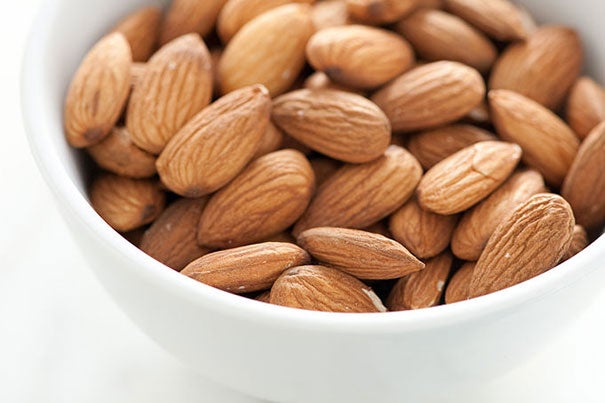
Those who ate nuts less than once a week had a 7 percent reduction in mortality; once a week, 11 percent reduction; two to four times per week, 13 percent reduction; five to six times per week, 15 percent reduction; and seven or more times a week, a 20 percent reduction in death rate, according to the study.
Creative Commons
Nut consumption reduces risk of death
Research also shows people who eat nuts weigh less
According to the largest study of its kind, people who ate a daily handful of nuts were 20 percent less likely to die from any cause over a 30-year period than those who didn’t consume nuts, say scientists from the Harvard-affiliated Dana-Farber Cancer Institute and Brigham and Women’s Hospital, and the Harvard School of Public Health.
Their report, published in the New England Journal of Medicine, contains further good news: The regular nut-eaters were found to be more slender than those who didn’t eat nuts, a finding that should alleviate fears that eating a lot of nuts will lead to overweight.
The report also looked at the protective effect on specific causes of death.
“The most obvious benefit was a reduction of 29 percent in deaths from heart disease — the major killer of people in America,” said Charles S. Fuchs, director of the Gastrointestinal Cancer Treatment Center at Dana-Farber, who is the senior author of the report and a professor of medicine at Harvard Medical School.
“But we also saw a significant reduction — 11 percent — in the risk of dying from cancer,” added Fuchs, who is also affiliated with the Channing Division of Network Medicine at Brigham and Women’s.
Whether any specific type or types of nuts were crucial to the protective effect could not be determined. However, the reduction in mortality was similar both for peanuts (a legume, or ground nut) and for tree nuts — walnuts, hazelnuts, almonds, Brazil nuts, cashews, macadamias, pecans, pistachios, and pine nuts.
Several previous studies had found an association between increasing nut consumption and a lower risk of diseases such as heart disease, type 2 diabetes, colon cancer, gallstones, and diverticulitis. Higher nut consumption also has been linked to reductions in cholesterol levels, oxidative stress, inflammation, adiposity, and insulin resistance. Some small studies have linked an increase of nuts in the diet to lower total mortality in specific populations. But no previous research studies had looked in such detail at various levels of nut consumption and their effects on overall mortality in a large population that was followed for more than 30 years.
For the new research, the scientists were able to tap databases from two well-known, ongoing observational studies that collect data on diet and other lifestyle factors and various health outcomes. The Nurses’ Health Study provided data on 76,464 women between 1980 and 2010, and the Health Professionals’ Follow-Up Study yielded data on 42,498 men from 1986 to 2010. Participants in the studies filled out detailed food questionnaires every two to four years. With each questionnaire, participants were asked to estimate how often they consumed nuts in a serving size of one ounce. A typical small packet of peanuts from a vending machine contains one ounce.
Sophisticated data analysis methods were used to rule out other factors that might have accounted for the mortality benefits. For example, the researchers found that individuals who ate more nuts were leaner, less likely to smoke, and more likely to exercise, use multivitamin supplements, consume more fruits and vegetables, and drink more alcohol. However, analysis was able to isolate the association between nuts and mortality independently of these other factors.
“In all these analyses, the more nuts people ate, the less likely they were to die over the 30-year follow-up period,” explained Ying Bao of Brigham and Women’s Hospital, first author of the report. Those who ate nuts less than once a week had a 7 percent reduction in mortality; once a week, 11 percent reduction; two to four times per week, 13 percent reduction; five to six times per week, 15 percent reduction; and seven or more times a week, a 20 percent reduction in death rate.
The authors noted that this large study cannot definitively prove cause and effect; nonetheless, the findings are strongly consistent with “a wealth of existing observational and clinical trial data to support health benefits of nut consumption on many chronic diseases.” In fact, based on previous studies, the U.S. Food and Drug Administration concluded in 2003 that eating 1½ ounces per day of most nuts “may reduce the risk of heart disease.”
The study was supported by National Institutes of Health and a research grant from the International Tree Nut Council Nutrition Research & Education Foundation.




